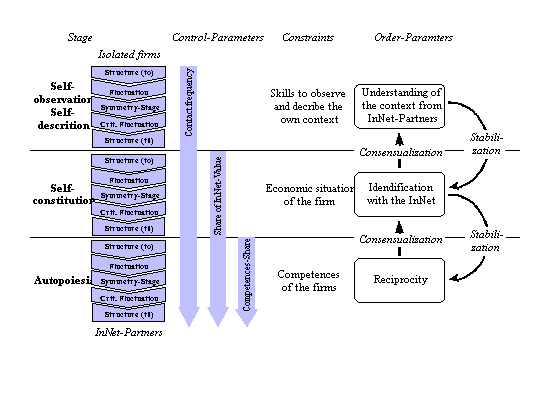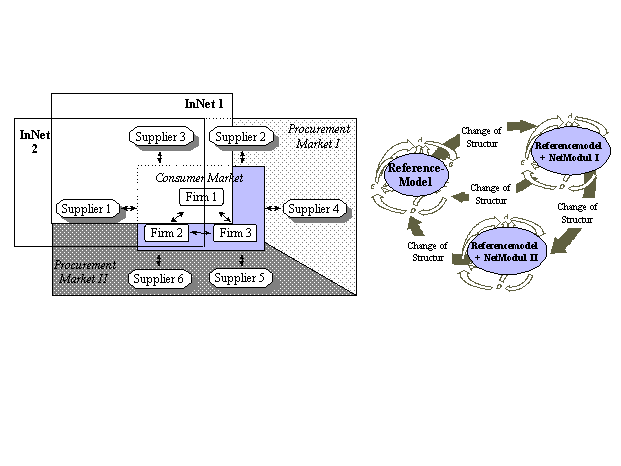
In scientific discussion, an abundance of completely heterogeneous theory approaches are used to explain the evolution process of InNets (Nohria/Eccles 92, Sydow 93, Bellmann/Hippe 96). Separately, none of the approaches is able to explain this process completely and comprehensively The variety of the explanation perspectives and the special terminology often obstruct the look for the heuristic potential developed in the individual approaches. Goal of the study and of the simulation model presented in this paper is, to generate a holistic explanation frame, which integrates the nuclear theses of several approaches. Theoretical base of the explanation frame are the "gradualistic autonomy concept" (Teubner 87) and the concept of "synergetics" (Haken 81). To explain the economic effects of InNets, the explanation frame includes the theses of the Transaction-Costs-Theory (Williamson 1985) and the Resource-Based-View (Rasche 94). Goal of the simulation is to describe and explain the short- and long-term sociological and economic consequences compound with InNets for each of the network-partners and for the whole market. Furthermore, the simulation should be able to support the network management by showing options to influence the evolution process and the InNet-success. In order to underline this goal InNets are analyzed in different market situations with different customer and competitor behavior. Criterions to judge the benefit, created from an InNet, is the long-term survivability and the potential to generate competitive advantages for the partners.
In the connection with this study InNets are defined as "varied, socio-technical relation-systems between largely autonomous firms to observe economic goals. Trough a double-attribution from market and hierarchy InNets have their own form of coordination, which allow stabile interaction-processes. As an result of more and more structured interaction InNets are constitute as autopoietic systems of higher order." (Mildenberger 96) By using the heuristical potential of Synergetics, the process of the conversion from individual social systems to an collective higher order system can be represented in a three-stage-evolution-process (see figure 1).

1. Stage (Self-description): InNets pursued strategic-evolutionary and not short-run efficiency oriented destinations. The problem areas, that are combined with this objective must be designated as weak-structured problems. Therefore, the problem and situation definition of the network partners is embossed through a very heterogeneous context. The extent of understanding the mutual contexts trough each InNet-partner (parallelizing of the cognitive systems) is the fundamentally factor of the success of an InNet. The contact frequency between the partners involved in the InNet is the single size to be influenced by the partners (control parameter).
2. Stage (Self-constitution): The distinguishing mark of the second stage is the identification-readiness of the partners with the InNet. Only if all partners believe, that the other partners act for the whole InNet an not for themselves, the InNet can growth. In economic systems the major element to show this, is the way, how the benefits of the InNet is shared among the InNet-partners.
3. Stage (Autopoiesis): InNets offers the chance to combine the single core-competences of the partners in a way, that the whole competence of the InNet is greater than the sum of the individual competences. Condition to realize this effect is the readiness of each partner to share his core-competence with all the other partners and the skill of each partner, to combine his own core- competence without any friction with the core-competences of all others.
One of the distinguishing mark of the simulation model is its hierarchical character. The model allows to analyze the consequences of the constitution and the realization of InNets for each InNet-partner, shows the evolution process from the perspective of the whole network an describes the effects and the repercussions from the InNet to the structure of the market (innovation time, customer behavior etc.). Based on the goal of the simulation the model must be able to reflect the effects of an InNet in different market situations with different competitive strategies followed by the competitors and different customer behavior. To analyze all the consequences of an InNet the model must represent the situation without an InNet, during the realization of an InNet and after the termination of the InNet. Additionally the model should represent the consequences of a second InNet; build with partially other partners. Because some of the structural connections are different in each situation, the term "the model" in the sense of one monolithic block is strictly speaking wrong. The total model presented here, shows one main-models with several different sub-modules. In reliance on the particular situation superordinate structure rules delete, replace or add parts of the main-model (see figure 2).

The reference model represents a market situation with three firms compete on one market. They do not compete with concrete products, but with their potential to solve customers needs (problem solution potential). All physical and immaterial products and services which are used for the satisfaction of a particular consumer need are subsumed under this term. The firms require OEM-parts, which are offered in two different procurement markets with tree suppliers in each market. In the reference model the only coordination mechanism is pure market. Cooperations between firms and supplier does not exist. As source to generate problem solution potentials the firms and suppliers can build up their core-competences, communication competences (learning skills), edge-competences, rationalization competences and innovation competences. Investments in several competences are the only decision variables of the model. With the first structure alternation to the network-modul I, one firm and two suppliers decides to build up an InNet. In this way, both, the firm and the suppliers leave the procurement market (single-sourcing- and single-customer-strategy). The only new decision variable integrated in the model is the amount of money, which the InNet-partners would invest to finance contacts. With the distinction between network-module I and network module II the model integrates the hypothesis, that InNets still have effects for the InNets-participants after the end of cooperation. Network-module I represents the situation, that none of the InNet-partner still gained any experience with this form of cooperation. In the contrast to this network-modul II represents the live-cycles of an InNet with two network experienced suppliers and one network inexperienced firm.
Bellmann, K.; Hippe, A. (96): Management von Unternehmensnetzwerken, Wiesbaden.
Haken, H. (81): Chaos and Order in Nature, Berlin und New York.
Mildenberger, U. (97): Interorganisationale Netzwerke: Ein Versuch der Begriffsexplikation, Arbeitspapier 97/1 des Lehrstuhls für Produktionswirtschaft der Universität Mainz, Mainz.
Nohria, N.; Eccles, R. (92): Networks and Organizations, Boston 1992.
Rasche, C. (94): Wettbewerbsvorteile durch Kernkompetenz, Wiesbaden.
Sydow, J. (93): Strategische Netzwerke, Wiesbaden.
Teubner, G. (87): Hyperzyklus in Recht und Organisation, in: Haferkamp, H.; Schmidt, H. (Hrsg.): Sinn, Kommunikation und soziale Differenzierung, Frankfurt, S. 87-128.
Williamson, O.E. (1985): The Economic Institutions of Capitalism, New York.